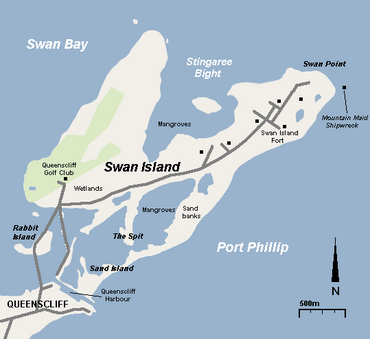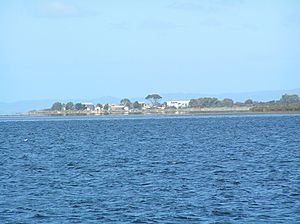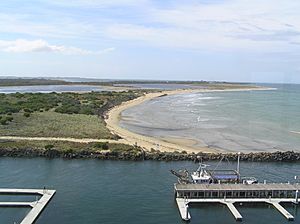Swan Island (Victoria) facts for kids
Quick facts for kids Swan IslandVictoria |
|||||||||||||||
|---|---|---|---|---|---|---|---|---|---|---|---|---|---|---|---|

Map of Swan Island
|
|||||||||||||||
| Postcode(s) | 3225 | ||||||||||||||
| Area | 1.40 km2 (0.5 sq mi) | ||||||||||||||
| LGA(s) | Borough of Queenscliffe | ||||||||||||||
| State electorate(s) | Bellarine | ||||||||||||||
| Federal Division(s) | Corangamite | ||||||||||||||
|
|||||||||||||||
Swan Island is a small sandy island in Victoria, Australia. It is about 1.4 square kilometers in size. The island helps separate Swan Bay from Port Phillip Bay. It is located near the town of Queenscliff on the Bellarine Peninsula. Swan Island is an official area within the Borough of Queenscliffe.
Contents
Exploring Swan Island
Swan Island is a unique place with different uses. It has a golf course and a special training facility for the Australian Defence Force. The island is also connected to another small island called Sand Island.
What You'll Find on Swan Island
The western part of Swan Island is home to the Queenscliff Golf Club. This club leases land from the Defence Department. The central and eastern parts of the island are used by the Department of Defence for training.
Swan Island also provides a way to get to the Queenscliff Cruising Yacht Club on Sand Island. You can reach Swan Island by a single-lane bridge and a raised road from Queenscliff. This road crosses a small island called Rabbit Island, which is covered in saltmarsh.
Accessing the Islands
Getting onto Swan and Sand Islands is usually limited. Only members of the golf and yacht clubs, Defence Department staff, or people with a special permit can enter. The main road to the islands has a security gate. The bay between the two main parts of Swan Island is called Stingaree Bight.
Understanding Sand Island
Sand Island is now connected to Swan Island. It was formed when a channel was dug to create the entrance to Queenscliff Harbour. To keep the harbour deep enough for boats, sand is regularly pumped out. This sand then drifts north-east, connecting Sand Island to Swan Island. This process has also created two lagoons (shallow bodies of water).
Nature and Wildlife on Swan Island
Swan Island is important for its natural environment. It has different types of plants and is a key spot for many birds.
Island Plants and Habitats
The island has areas of coastal scrub (tough plants that grow near the sea). There are also small patches of coastal woodland (trees near the coast). Large areas of saltmarsh are also found here. Saltmarsh is a type of wetland that grows in salty water.
Important Bird Area
Swan Island is part of a special area called the Swan Bay and Port Phillip Bay Islands Important Bird Area. This area is recognized by BirdLife International because it is vital for many birds. These include orange-bellied parrots, waders (birds that feed in shallow water), and seabirds.
Home to Rare Parrots
The island is especially famous for the critically endangered orange-bellied parrot. The saltmarsh on Swan Island is one of the few places where these rare parrots spend their winters.
Sand Island's Role for Birds
Sand Island has lagoons surrounded by saltmarsh. New dunes (sand hills) on the eastern side are growing with new shrubs and grasses. The eastern beach of Sand Island, now linked to Swan Island, is a very important resting spot for migratory waders. These birds feed on the mudflats in Swan Bay when the tide is low. The lagoons on Sand Island are also popular with black swans and other waterbirds.
Swan Island's Past
Swan Island has a long and interesting history, especially with the military.
How the Island Got its Name
The island was named by Acting Lieutenant John Murray. He explored Port Phillip Bay in a ship called the Lady Nelson in February 1802.
Military History
Swan Island has been used by the military for a long time. In the 1850s, during the Crimean War, fortifications (strong defensive buildings) were built here. These were meant to protect the entrance to Port Phillip Bay. The defenses on Swan Island were controlled from Fort Queenscliff. During the First World War, the Navy used the island to store sea mines.
Old Railway Line
From 1886 to 1958, a narrow-gauge tramway (a small railway) linked the island to the Queenscliff railway station. This tramway was used to transport goods for military purposes.
Shipwrecks Near the Island
Several ships have sunk off Swan Island over the years.
The Mountain Maid
The wooden cargo ship Mountain Maid sank near Swan Island in 1856. This happened after it crashed into another vessel. Today, it is a well-known spot for dive wrecks.
HMAS J3 Submarine
The J-class submarine HMAS J3 was purposely sunk off the north-east point of Swan Island in 1924. Its services were no longer needed.
HMVS Countess of Hopetoun
The hull (body) of the Colonial Service torpedo boat HMVS Countess of Hopetoun was also scuttled (purposely sunk) here in 1925. Before it was sunk, valuable parts were removed. Its bow (front part) could be seen sticking out of the water for some time afterward.
Swan Island Training Area
Swan Island is an important training area for the Australian military.
Military Use of the Island
For many years, different parts of Swan Island were used by both the Navy and the Army. In 1961, the Department of Army took over the entire facility.
Training Activities
The Army Reserve's 1st Commando Regiment manages the Swan Island Army Detachment (SIAD). They conduct various training activities there. Some of these activities are kept secret. In 2006, the Minister of Defence stated that Swan Island is a Military Exercise Area. It is used for naval radar flare training, Army Reserve training, and a small demolitions range.
Historical Claims and Training
Authors Brian Toohey and William Pinwill wrote a book in 1989. They claimed that the Australian Secret Intelligence Service (ASIS) acquired part of the island in 1961 for a training facility. These claims have never been officially proven. However, in 1983, SIAD did provide training for an ASIS program. This program aimed to train a team to rescue Australians held by terrorists overseas.
In April 2004, a new law allowed ASIS to be involved in certain activities outside Australia. This includes using weapons for self-defense. It is believed that ASIS officers receive training from SIAD in these skills.
Protests at the Training Area
People who are against war sometimes protest at the training area. They have entered the area and been arrested by Victoria Police for trespassing. They then plead guilty in court. In 2014, some protestors entered the training area. Some were stopped by soldiers, and others by police. All pleaded guilty to trespassing. An inquiry by Defence led to soldiers being advised on how to handle such situations.
Images for kids




